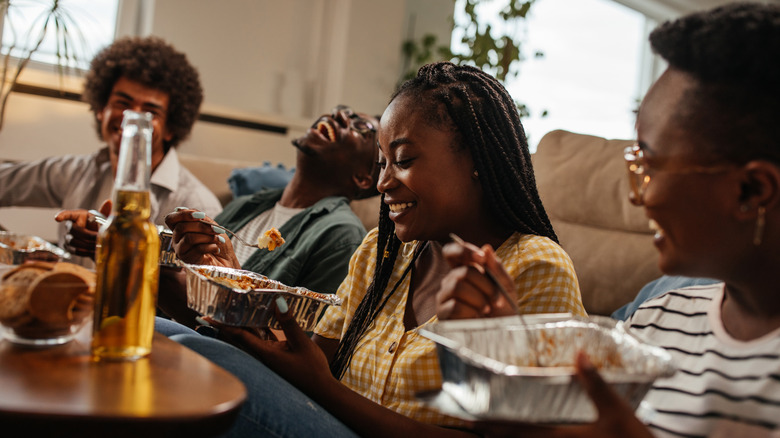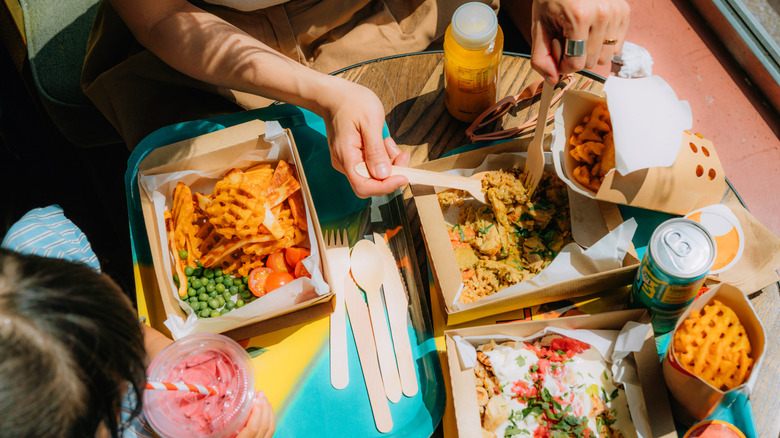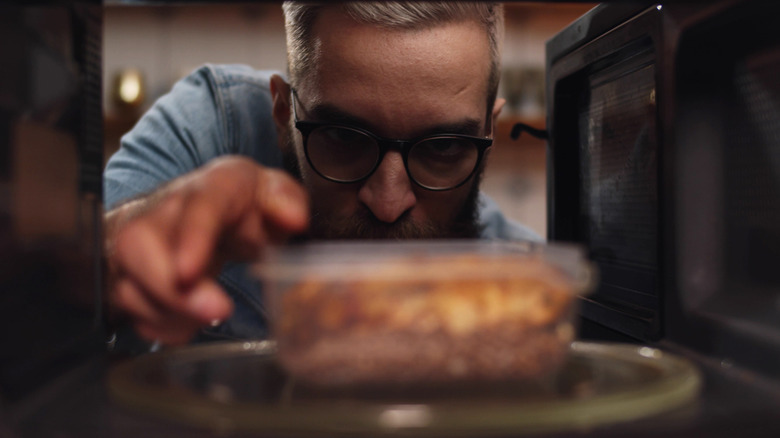Your Takeout Order Isn't Safe To Eat If It Looks Like This
As much as takeout is an easy and delicious option when the last thing you want to do is cook, it's not always the best idea. For starters, you never really know what's going on in the kitchen of a restaurant. Even the cleanest kitchens in the world are not free from the occasional nosy little critters who want to check things out. There's also the matter of what hands may have become a little too friendly with your food during preparation, and, if that weren't enough, from the time your meal is done to the time it's delivered to you, there could be some unsanitary issues brewing. In other words, if your meal that was supposed to be hot arrives looking anything but that, it's probably not safe to eat.
"As food enters the temperature zone at or near room temperature, the microorganisms that have contaminated the food will proliferate rapidly," food scientist Bryan Quoc Le told HuffPost, adding that the rate at which bacteria proliferates varies based on the salt and sugar content, as well as the levels of moisture and acidity. "If the number of pathogens in the food reaches a critical number, they can cause foodborne illness in the consumer," said Le.
But does this mean you should delete all your food delivery apps immediately and start cooking every meal you're going to eat? Not quite. If you're aware of the potential for food poisoning that can result from delivery or takeout, then you can take the necessary precautions to avoid it.
Don't give your takeout order time to grow bacteria
Once your delivery arrives, you want to eat it immediately. That means if you're having a Chinese food and movie night, make sure you know what movie you're going to watch and have it set up and ready to go. You don't want to receive your delivery and leave it on the counter while you fuss with setting the mood for the evening.
If something comes up and you can't dive into that bag of delivery deliciousness, then put it in the refrigerator until you're able to consume it. According to the U.S Department of Agriculture, when food is left out between 40 and 140 degrees Fahrenheit — also called the "danger zone" — bacteria can grow so quickly that they can double in amount in 20 minutes. In fact, it's in this temperature range that Bacillus cereus, Staphylococcus aureus, E. coli, Clostridium perfringens, and strains of Salmonella show up to the party to do their worst. Food should never go unrefrigerated for more than an hour, and if you're dealing with hot weather, like 90 degrees Fahrenheit or more, leaving food out for as little as an hour can prove problematic.
While a stomach bug may not seem like the end of the world, it can be extremely dangerous. According to the U.S. Centers for Disease Control and Prevention, of the estimated 48 million people who get food poisoning every year, for 128,000 of them, their symptoms are so bad that they need to be hospitalized, and 3,000 don't survive.
How to stay safe and prevent food poisoning
In addition to always eating your delivery as soon as possible, you also want to rely on your senses. For example, if you've ordered the same thing multiple times from the same place and this time it smells off or, even worse, doesn't taste right, then don't eat it. As much as it's wasteful to throw out food, it's better than getting sick. You also want to order from reputable places that you've, ideally, actually set foot in before.
When placing a delivery order, be smart in your choices. If it's a sweltering 95 degrees Fahrenheit outside, skip ordering things like sushi or dairy products that can easily and quickly spoil. Even if you're not placing an order in mid-July, you want to make sure that meats, poultry, especially, and fish are always properly cooked, per the UConn College of Agriculture, Health and Natural Resources.
If you do end up having to reheat your takeout food, make sure you do so at 165 degrees Fahrenheit to eliminate any possible bacteria that have found a home in your meal. (Also, never microwave your food in plastic to avoid chemical exposure.) When it comes to storing leftovers, you want to properly pack them in an airtight container and refrigerate them within two hours of receiving your food. The best temperature to keep your food at is 40 degrees Fahrenheit or below, according to the U.S Department of Agriculture.
Granted, nothing can always be 100% safe when getting takeout or even preparing food at home. Sometimes food becomes contaminated through no fault of our own. So if you start to feel sick after eating something, don't hesitate to call your doctor.


